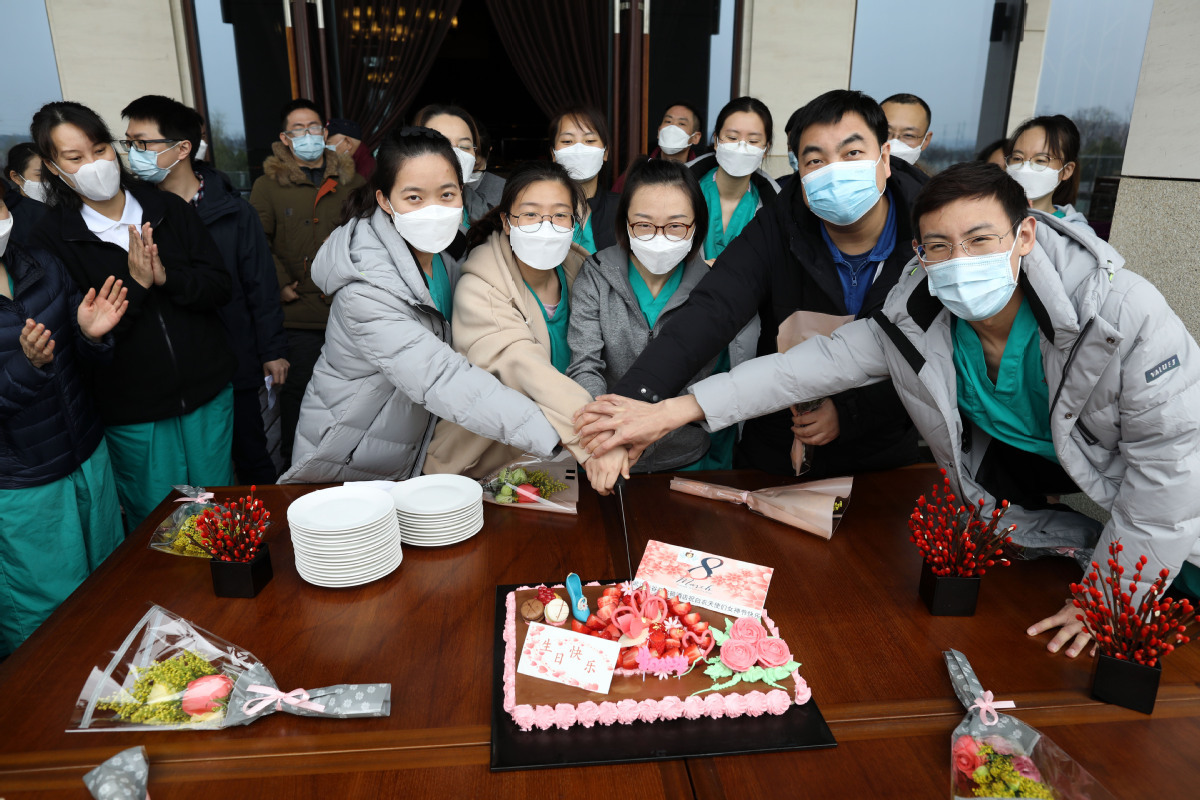
Over 50 percent of doctors and more than 90 percent of nurses on the frontlines in Wuhan are female.
The National Health Committee said 28,000 out of the 42,600, or two-thirds, medical workers who went to Hubei Province from across the country to fight the outbreak were women.
When a team of 138 medical workers sent by the Beijing municipal government to Wuhan, over half were female. Since January, this same Beijing team had treated more than 300 patients, 90 percent of whom were in serious or critical condition.
And yet experts have said that more needs to be done through institutional reforms so that women are treated the same as their male counterparts and get equal chances to be promoted based on their professional merit and performance.
Today’s Story in the Story looks at China’s female doctors who are on the fighting the coronavirus on the frontlines in Wuhan, Hubei Province.

Medical workers from China-Japan Friendship Hospital hold a birthday party for five medics whose birthday is in March, on March 8, also International Women's Day, in Wuhan, Central China's Hubei province. (Photo: China Daily)
Zhang Jixian is considered the first doctor to report the novel coronavirus before its outbreak.
She works as the director of respiratory and critical care medicine department of the Hubei Provincial Hospital of Integrated Chinese and Western Medicine.
The Hubei government awarded a grand merit to Zhang on February 6 for her contributions.
A senior couple living in the residential community near Zhang's hospital went to see her for their fever and cough on December 26, 2019. By observing their CT thorax images, Zhang found differences from pneumonia caused by common viruses.
Zhang asked the couple to have their son examined in the hospital. She found the CT image of his lung was similar to his parents.
That day, a patient from Huanan Seafood Market in Wuhan who had a fever and cough also had a similar CT image of the lung.
The seafood market in Wuhan has been widely considered the source of the novel coronavirus outbreak, which initially hit Wuhan and then spread across China.
"Usually, a family comes to the hospital and there is little chance for all the family members to have the same disease except for infectious diseases," said Zhang who gave the couple's family and the patient from the seafood market tests denying the possibility of flu.
As the situation continued to confuse Zhang, she reported it to the head of the hospital on December 27 and the hospital then reported it to the disease control and prevention center in the Jianghan district of Wuhan.
On December 28 and 29, the hospital took three patients from Huanan Seafood Market. They demonstrated similar symptoms with Zhang's four patients from a few days earlier. Zhang suggested the hospital consult doctors from different departments.
Xia Wenguang, a dean of the hospital, called 10 experts from different departments, including respiratory, cardiovascular, ICU and infection, to discuss symptoms of the seven patients. They concluded the situation was unusual and deserved special attention. After admitting the old couple and their son into the hospital, Zhang divided an area in the ward to make a quarantine area with nine beds.
Zhang's hospital is one of those located nearest to the Huanan Seafood Market and she later received many patients with similar symptoms to the first seven patients.
After receiving the old couple and their son, Zhang asked all the doctors and nurses in her department to wear N95 face masks. She also had working staff of her department order 30 sets of white uniforms made of fine canvas and asked the doctors and nurses to wear them inside their working uniforms.

Zhang Jixian, director of respiratory and critical care medicine department of the Hubei Provincial Hospital of Integrated Chinese and Western Medicine (Photo: GT)
Thanks to Zhang's precaution, even though the hospital received an increasing number of novel coronavirus patients, no medical staff in Zhang's department had been infected.
Zhang said that her strong protection awareness came from her experience of fighting against SARS in 2003 - she was one member of the expert team which went to residential communities every day to check suspected cases.
"There are too many patients and the medical care personnel are worn out. I almost shed the most tears in my life during these days," she said.
She said they never saw the novel coronavirus before, and they never saw so many patients swarming into the hospitals. She cried when the disease claimed the lives of some patients, when protective suits were running low, and when there were no face masks.
But after crying, she would go back to her patients and work. Zhang noted that the struggle against the coronavirus is important and there is much work that needs to be done as soon as possible.
(Produced by Nancy Yan Xu, Lance Crayon, Brian Lowe and Da Hang. Music by: bensound.com. Text from Global Times and China Daily)


